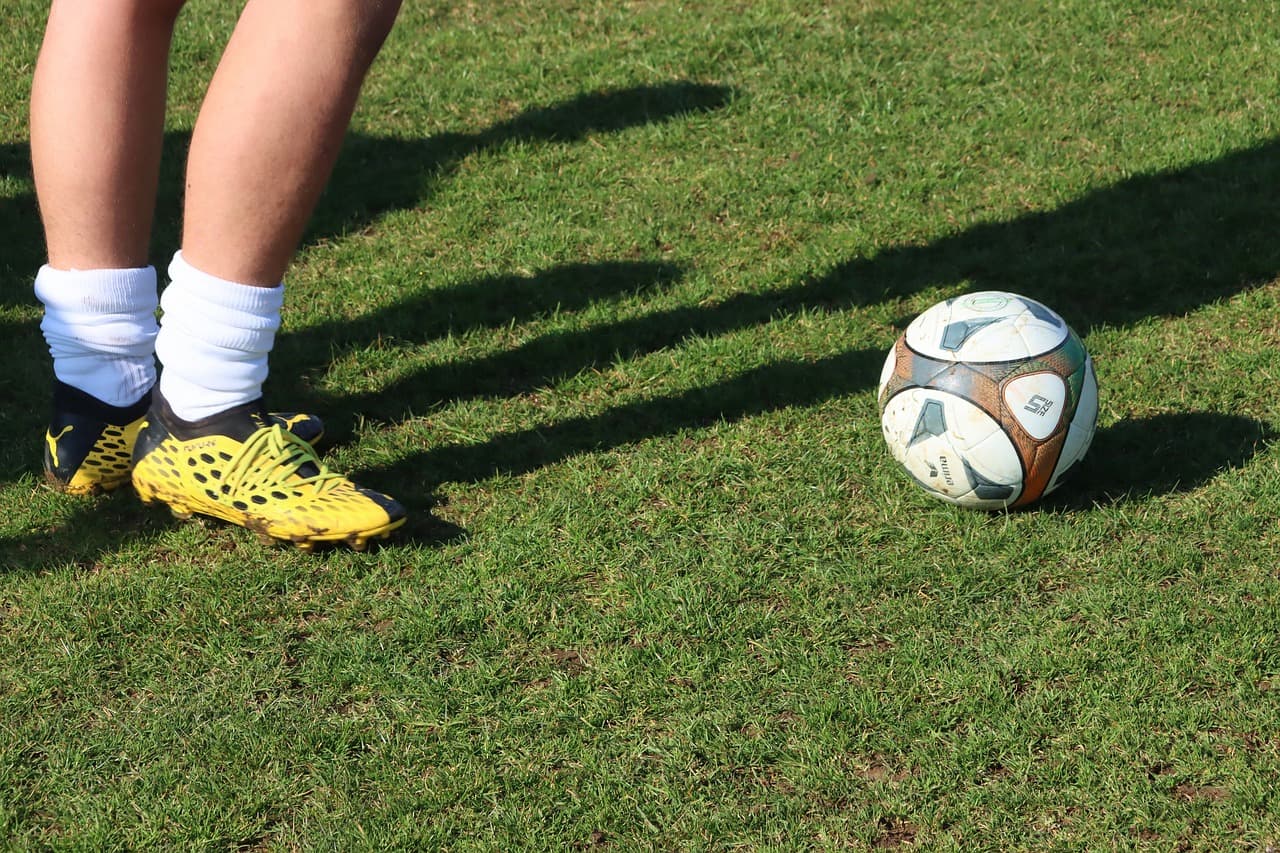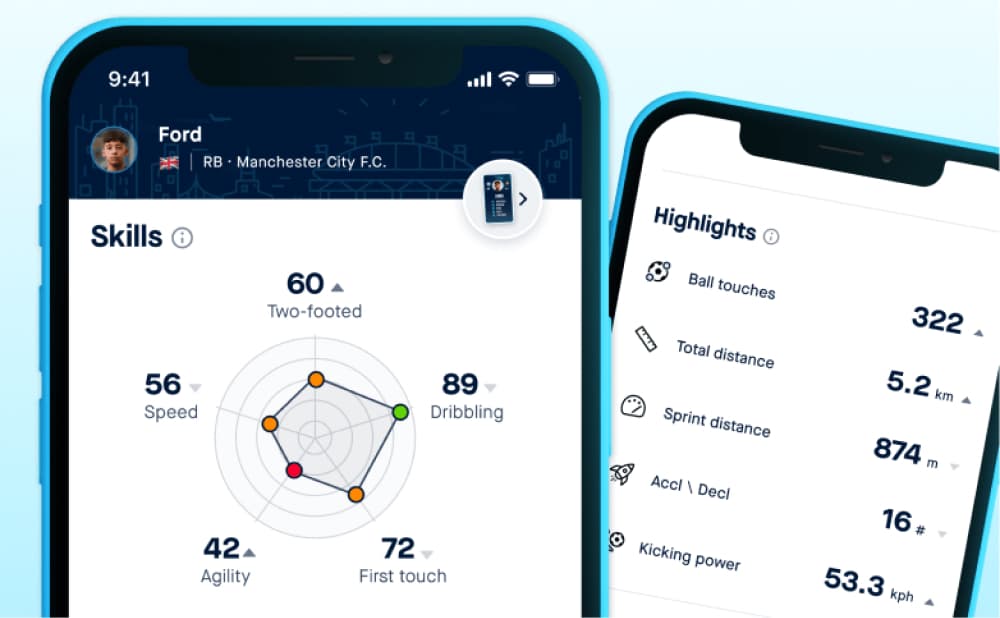What is a Soccer Tracker?
Soccer trackers are wearable devices that capture and analyze multiple different performance metrics in real-time, including speed, distance, acceleration, and heart rate.
They use GPS, sensors, and data analysis to evaluate players’ performance during games giving back in depth analysis that can then be used to improve players performance or strategy development.
Professional teams like Manchester City, Real Madrid, and Barcelona use these devices to optimize player performance, prevent injuries and help player recovery.
How do Soccer Trackers Work
Sensors and GPS Technology
Soccer trackers operate using 3 core technologies: GPS tracking, accelerometers, and gyroscopes. The GPS system tracks player position and movement with accuracy up to 10 centimeters, while motion sensors capture detailed movement data 1000 times per second.
Data Collection and Analysis in Real Time
These devices collect multiple primary data points such as speed, acceleration, distance, heart rate, and player load. The information transmits to central systems every 0.1 seconds, allowing coaches to make immediate tactical decisions based on player performance data, or allowing players to review the data later through an app or dashboard.
Integration with Mobile Apps and Dashboards
Modern soccer trackers connect seamlessly with many software components: mobile apps, web dashboards, team management systems, video analysis tools, and performance databases. This integration provides instant access to performance metrics as well as historical data.
Types of Soccer Trackers
Wearable Soccer Trackers
Wearable trackers come in 4 common forms: vest-mounted devices, arm bands, chest straps, and clip-on units. Each option caters to different needs, whether you’re prioritizing comfort, accuracy, or ease of use.
Playmaker offers a unique approach by attaching sensors directly to players’ cleats. This design captures detailed data on foot-to-ball interactions, including metrics such as ball touches, kicking velocity, and leg usage.
By focusing on the feet, Playermaker provides insights into technical skills that traditional trackers might overlook.
Smart Apparel with Built-In Tracking
Smart soccer apparel integrates 3 tracking technologies: embedded sensors, conductive fabrics, and wireless transmission systems. Together, they make it possible to monitor movement patterns, muscle activity, and overall performance without sacrificing comfort or mobility during play.
Sensor-Based Soccer Balls
Smart soccer balls contain built-in sensors that measure 6 key metrics: ball speed, spin rate, strike force, trajectory, contact point, and flight path. This combination of insights helps players and coaches break down the finer details of performance, from improving kick accuracy to mastering specific techniques.
App-Based Soccer Trackers
Mobile applications utilize smartphone sensors to track 5 basic metrics: distance covered, sprint speed, positioning, movement patterns, and game duration. These affordable solutions offer entry-level tracking capabilities for amateur players.
What to Look for When Buying a Soccer Tracker
User-Friendly Interface
The best soccer trackers feature 3 essential interface elements: intuitive navigation, clear data visualization, and customizable dashboards. You want something that delivers key metrics at a glance without feeling overly complex.
Support
Reliable support can make all the difference. Top-tier brands back their trackers with technical assistance, firmware updates, data recovery, and training resources.
Durability
Soccer isn’t exactly gentle on equipment, so your tracker needs to handle tough conditions. Professional-grade devices are built to endure impacts up to 5G, have water resistance (IP67 standards), and operate smoothly in temperatures ranging from -10°C to 45°C.
Accuracy and Reliability
Top-tier tracking devices maintain 95% accuracy in 4 key areas: position tracking, speed measurement, distance calculation, and physiological monitoring.
Battery Life
Long battery life is a must, especially for players who train or compete for extended periods. Aim for trackers with at least 6 hours of continuous use, 72 hours of standby, and a lifespan of 1000 charge cycles to ensure you’re not constantly worrying about recharging.
Value for Money
A great tracker balances price with features, durability, and support. High-quality options range from $200 to $2000, depending on the technology and capabilities.
What Key Metrics Do Soccer Trackers Measure?
Soccer trackers are powerful tools that deliver a wealth of insights by measuring both physical and skill-based metrics. These data points give players and coaches a complete picture of performance and areas for improvement. Here’s a closer look at what they track:
Physical Metrics
Distance
Trackers measure the total distance covered during a match or training session. This is a key indicator of stamina and effort, offering a glimpse into a player’s work rate and fitness level.
Speed
Speed metrics include both maximum speed and average pace. These figures help evaluate a player’s physical capabilities, such as explosive power and their ability to maintain tempo throughout the game.
Endurance
Endurance data highlights how consistently players can maintain performance levels over time. This is especially critical in competitive matches, where lapses in stamina can affect the team’s overall effectiveness.
Devices track 5 endurance indicators: stamina levels, fatigue index, recovery time, workout intensity, and cardiovascular load.
Skill-Based Metrics
Ball Control & Dribbling
Trackers assess ball control through stats like dribbling frequency and success rate. These numbers reveal a player’s ability to navigate the field under pressure and their proficiency in maintaining possession.
Sensors in soccer trackers capture 4 technical aspects: touch quality, dribbling speed, ball control consistency, and movement efficiency.
Pass Accuracy
By tracking successful vs. missed passes, trackers provide insight into a player’s passing precision. Accurate passing is a cornerstone of effective possession play and key to creating scoring opportunities.
Systems typically analyze 3 passing metrics: completion rate, pass power, and distribution patterns during matches and training.
Positional and Tactical Data
Modern trackers collect positional data, offering a detailed view of player formations and tactical setups. Analyzing this information allows coaches to optimize strategies, improve positioning, and identify gaps in coverage or opportunities to exploit opponents.
Trackers record positional elements such as: heat maps, movement patterns, tactical formations, team shape, pressing intensity, and spatial coverage.
Recovery and Fitness Levels
Trackers monitor recovery time, measuring how quickly players bounce back after intense physical effort. This is essential for ensuring peak productivity during matches and minimizing injury risks.
Heart Rate and Endurance Levels
Heart rate monitoring provides an accurate measure of a player’s endurance over time, helping trainers design personalized programs to boost cardiovascular fitness and tailor recovery sessions.
Systems typically track 5 cardiovascular metrics: resting heart rate, maximum heart rate, heart rate zones, recovery rate, and cardiac efficiency.
Benefits of Using a Soccer Tracker
Using a soccer tracker offers a host of benefits, making it an essential tool for players and teams looking to elevate their game. From fine-tuning individual skills to optimizing team strategies, here are 5 ways trackers make an impact:
Performance Monitoring & Analysis
Trackers provide performance benefits such as real-time feedback, historical comparison, personalized benchmarks, progress tracking, performance optimization, tactical insights, and injury prevention data.
Trackers deliver real-time feedback, enabling players and coaches to adjust on the fly. They also provide data for historical comparison, helping set personalized benchmarks and track progress over time.
By identifying strengths and areas for improvement, trackers aid in performance optimization, provide tactical insights, and even highlight risks to prevent injuries.
Skill Development and Technical Improvement
For individual players, trackers shine in improving technical skills. They offer detailed insights into ball control, passing accuracy, shooting power, movement efficiency, and tactical awareness. These metrics help players focus on targeted areas to enhance their overall game.
Injury Prevention
One of the most practical advantages of trackers is their role in injury prevention. They monitor fatigue levels, help with load management, track recovery progress, and analyze movement patterns to identify potential risks before they lead to injury.
Improved Team Performance
Teams can leverage tracking data to boost collective performance. Insights include tactical coordination, player positioning, team workload, and match intensity. These metrics also assist in squad rotation decisions and help refine game strategies for better results on the pitch.
Motivation and Goal Setting
Tracking data serves as a motivational tool by offering clear performance goals and progress visualization. Players can use it for competitive benchmarking, track their achievements, and focus on continuous improvement, keeping the drive to excel alive.
How a Soccer Tracker Can Improve Player Performance
In conclusion, soccer trackers are not just tools but game-changers in modern soccer. By leveraging real-time data, players gain precise insights into key metrics like speed, endurance, ball control, and recovery, turning numbers into meaningful actions that lead to success.
These devices empower athletes and coaches with actionable insights into speed, endurance, ball control, and recovery, turning raw data into strategies that drive success on the field.
From injury prevention to refining team dynamics or enhancing individual performance, soccer trackers provide a competitive edge that was once unimaginable.
For professionals and amateurs alike, embracing this technology is a step toward unlocking untapped potential and achieving peak performance. In today’s game, the field isn’t the only place where soccer is played—data has become just as vital to unlocking potential and reaching peak performance.






